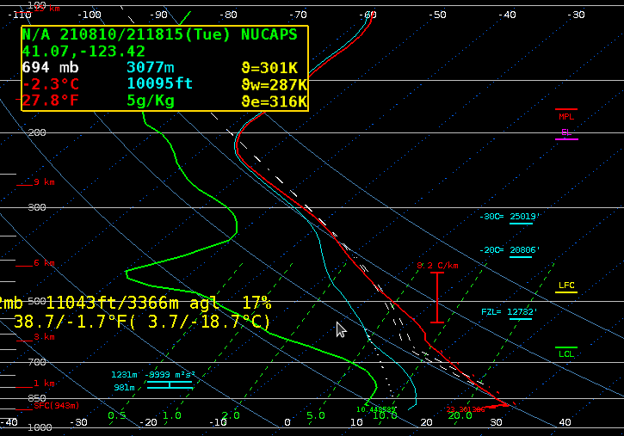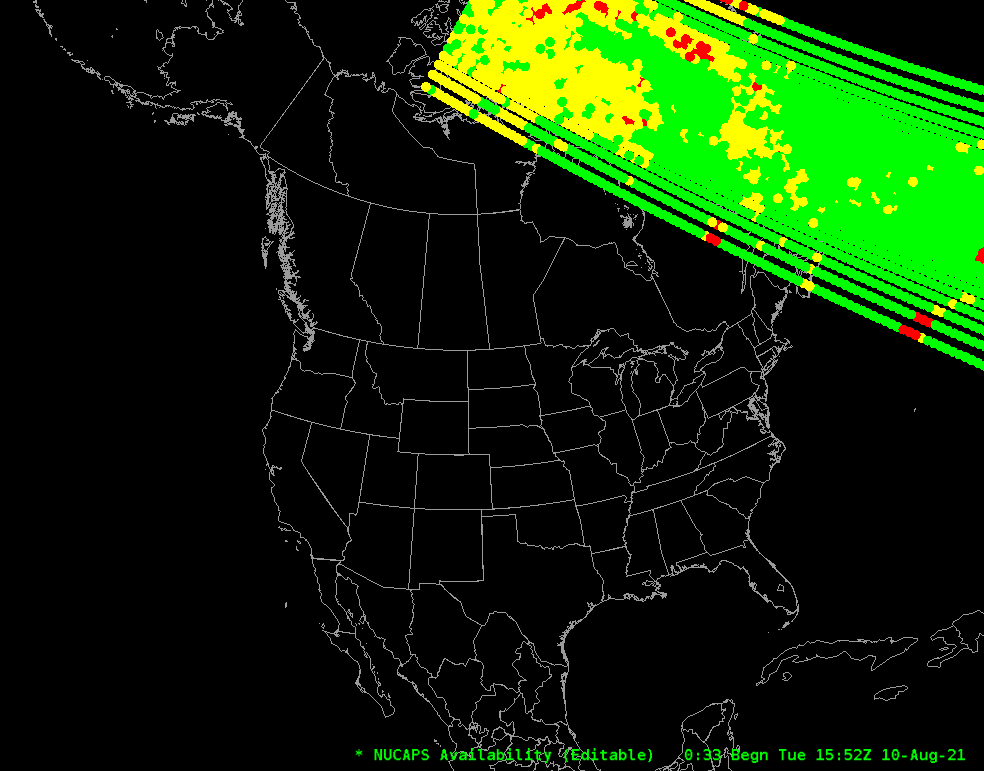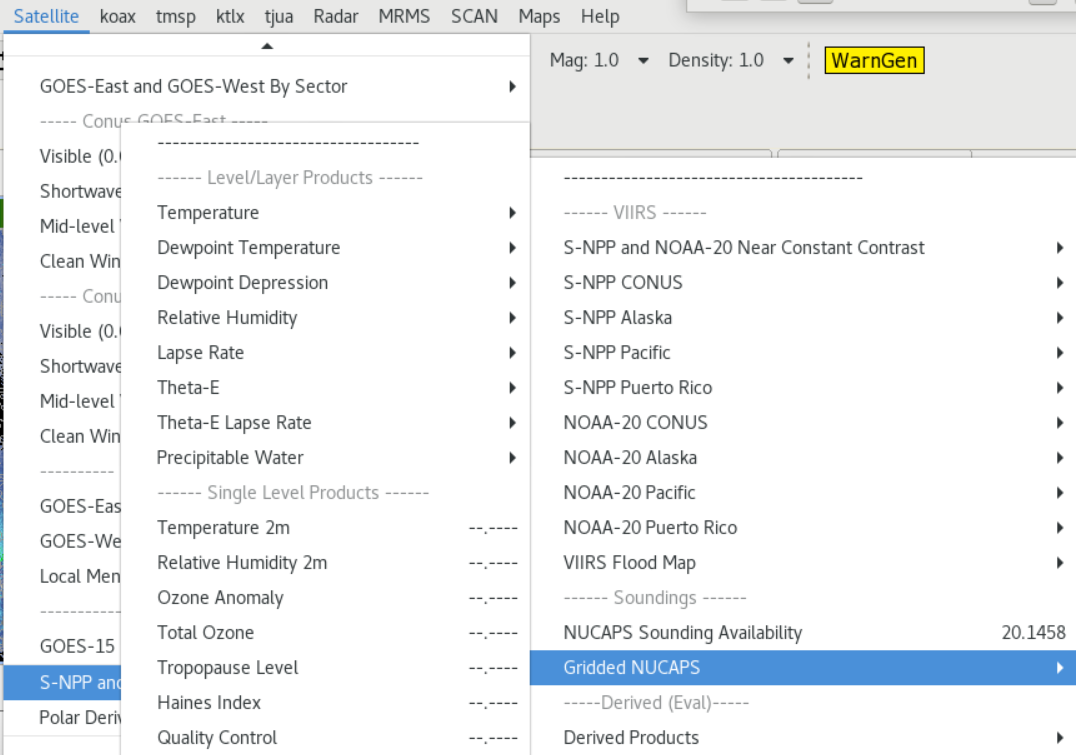NUCAPS - Total Operational Weather Readiness - Satellites (TOWR-S)
NOAA-Unique Combined Atmospheric Processing System
NOAA-21 NUCAPS coming on or after May 9, 2024
About
NUCAPS (the NOAA-Unique Combined Atmospheric Processing System) combines observations from the Cross-track Infrared Sounder (CrIS) and Advanced Technology Microwave Sounder (ATMS) aboard NOAA's JPSS, and EUMETSAT's Metop polar-orbiting satellites.
NUCAPS data consist of vertical atmospheric profiles detailing the temperature and moisture at multiple elevations. AWIPS displays locations of available soundings, color-coded based on their cloud cover.
AWIPS users can display a Skew-T plot for any selected data point to highlight unstable or pre-convective conditions. Additionally, AWIPS can interpolate 2D gridded views of various parameters including temperature, dewpoints, relative humidity, and precipitable water across multiple soundings at any of 9 elevations, as well as near-surface Temperature and Humidity, Total Column Ozone, Tropopause Level, and Haines Index.
Limitations
Cloud Visibility: Cloud cover degrades NUCAPS estimates of atmospheric conditions.
Satellite Platform: AWIPS no longer receives NUCAPS data from S-NPP.




AWIPS
Location: Satellite → JPSS Polar → NUCAPS Sounding Availability
Satellite → JPSS Polar → Gridded NUCAPS
Color Maps: Sounding availability due to cloud cover: green=good; yellow=marginal (Microwave only); red=no retrieval
Sampling: N/A
Quality Flags: N/A
Technique: NUCAPS has the potential to support basic and applied geophysical science research/investigation, direct broadcast, nowcasting and Scientific Data Record (SDR) monitoring. Near real-time retrievals of NUCAPS temperature and moisture profiles can aid in warnings of severe weather, for example atmospheric stability conditions for tropical storms as well as for tornado warnings. For the latter retrieval products of higher spatial resolution (~10km) are needed. Additionally, NUCAPS trace gas products can be useful to air quality forecasting and climate studies.
AWIPS Technical Details
| Sector |
NOAA-20/21: 30-second granules (200 granules/orbit); 3600km swath width; (BUFR regions 01-09) Metop-C: 3-minute granules (34 granules/orbit); 2,100 km swath width (BUFR regions 01-09) |
| Refresh Rate |
NOAA-20/21: each ~1,800 files/day; 0-100 files/hour. Metop-C: 300 files/day for Regions 01-09; 0 to 17 files/hour CONUS latitudes: typically 2 passes from each of the two JPSS satellites, at 0200-0400 and again 1400-1600 local solar time. Metop-C overpasses are around 9:00 and 21:00 local time. More frequent overpasses in higher latitudes; fewer south of CONUS latitudes. |
| Size |
NOAA-20/21: 212KB per 30-second granule Metop-C: 867KB per 3-min granule |
| Horizontal Resolution | 50-135km between profiles |
| Data Source | NOAA-20/21 → IDPS → NDE; Direct Broadcast via CIMSS or GINA |
| Projection |
NOAA-20/21: Each 30-second granule has 120 profiles with 101 pressure levels Metop-C: Each 3-min granule has 660 or 690 profiles with 101 pressure levels |
| Storage Location | /data_store/nucaps/yyyymmdd/hh |
| WMO Header |
NOAA-20/21: IUTN1[1-9] KNES Metop-C: IUTN0[1-9] KNES |
| Product Short Name |
NOAA-20/21: NUCAPS_EDR_IUTN1[1-9]_KNES Metop-C: NUCAPS_EDR_IUTN0[1-9]_KNES |
| Data Path | PDA → NCO → NCF → SBN (NMC3 channel) |
| AWIPS Configuration | styleRules/nucapsImageryStyleRules.xml (gridded NUCAPS) |
| AWIPS Plugin | NUCAPS (sounding availability -> Skew-T plots); Also Gridded NUCAPS |
| Edex Purge Rule | 24 hours (baseline) |
Use Cases & More
Gridded NUCAPS - E. Berndt, Satellite Book Club #13, August 13, 2020
Severe Weather - C. Shultz, STAR 2020 Workshop, February 2020
More information can be retrieved from STAR, OSPO, CIRA, GINA, the End-User Manual, and this training module
Point of Contact: Awdhesh (AK) Sharma, Ken Pryor, Murty Divakarla
This page was last updated on May 6, 2024




